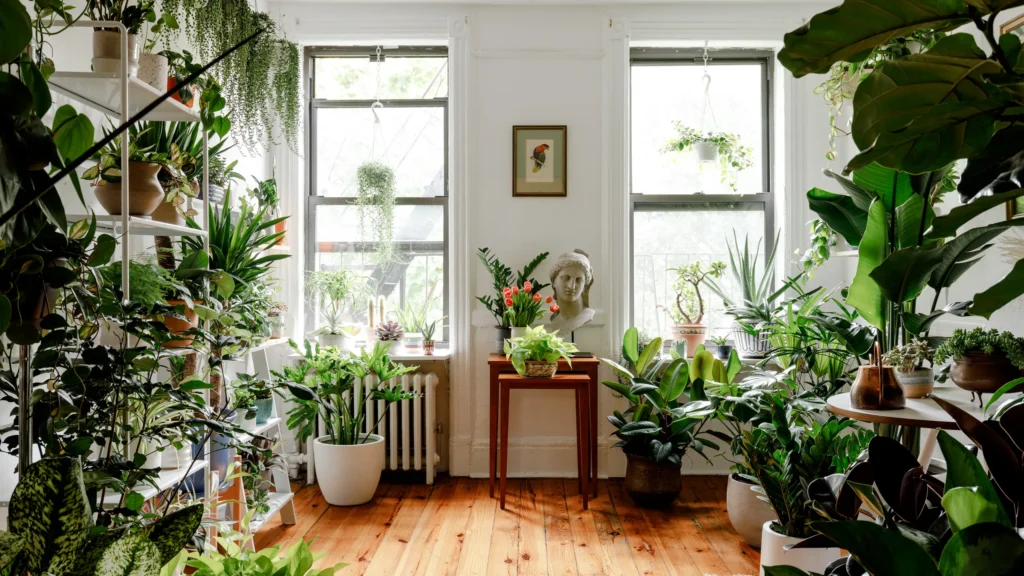Indoor plants are an amazing way to brighten up any room. They not only add a splash of green but also bring many health benefits. If you’re looking to turn your home into a green oasis, you’ve come to the right place. Let’s explore some beautiful indoor plants that are perfect for your home.
Why Have Indoor Plants?
Indoor plants are more than just pretty decorations. They have several benefits that make them a great addition to any home. Here are a few reasons why you should consider adding some beautiful indoor plants to your space:
- Air Purification: Many indoor plants are known for their ability to purify the air. They can remove toxins and produce fresh oxygen, making the air you breathe cleaner and healthier.
- Mood Boosters: Plants can improve your mood and reduce stress. Just looking at a plant can make you feel more relaxed and happy.
- Improved Focus: Having plants around can help you concentrate better. They create a peaceful environment that can boost your productivity.
- Natural Decor: Indoor plants are a fantastic way to add a touch of nature to your decor. They can make any room feel more welcoming and alive.
- Easy Maintenance: Many indoor plants are easy to take care of. They don’t need much water or sunlight, making them perfect for busy people or those new to gardening.
Now that you know why indoor plants are great, let’s dive into some of the best and most beautiful indoor plants you can have in your home.
Best Indoor Plants for Your Home
1. Snake Plant
The snake plant, also known as the mother-in-law’s tongue, is a popular choice for indoor gardening. Its tall, upright leaves have a unique pattern that looks great in any room. The snake plant is very easy to care for and can thrive in low light conditions. It also helps to filter out toxins from the air, making it a healthy addition to your home.
2. Spider Plant
The spider plant is another easy-to-care-for option. Its long, arching leaves with white stripes make it a beautiful indoor plant. Spider plants are great for hanging baskets or pots on shelves. They are known for their ability to remove pollutants from the air and are safe for pets.
3. Peace Lily
The peace lily is a stunning plant with dark green leaves and elegant white flowers. It’s perfect for adding a touch of elegance to any room. Peace lilies prefer indirect sunlight and need to be watered regularly. They are excellent at improving indoor air quality by removing toxins.
4. Pothos
Pothos, also known as devil’s ivy, is a versatile indoor plant that can grow in various conditions. It has heart-shaped leaves that come in different shades of green and yellow. Pothos can be grown in pots, hanging baskets, or even water. It’s very low maintenance and can tolerate low light and irregular watering.
5. ZZ Plant
The ZZ plant is known for its thick, waxy leaves that add a glossy green touch to any space. This plant is incredibly resilient and can survive in low light and with infrequent watering. The ZZ plant is perfect for beginners or those who travel frequently.
6. Monstera
Monstera, also known as the Swiss cheese plant, is famous for its large, unique leaves with natural holes. It’s a statement plant that can add a tropical vibe to your home. Monstera plants prefer bright, indirect light and need to be watered regularly to keep their soil moist.
7. Fiddle Leaf Fig
The fiddle leaf fig is a trendy indoor plant with large, violin-shaped leaves. It’s perfect for adding height and drama to a room. Fiddle leaf figs need bright, indirect light and consistent watering to thrive. They can be a bit finicky but are well worth the effort for their stunning appearance.
8. Aloe Vera
Aloe vera is not only a beautiful plant but also has many medicinal uses. Its thick, succulent leaves contain a gel that can be used to treat burns and cuts. Aloe vera plants prefer bright light and need to be watered sparingly, making them easy to care for.
9. Rubber Plant
The rubber plant has shiny, dark green leaves that can grow quite large. It’s a striking plant that can add a touch of sophistication to any room. Rubber plants prefer bright, indirect light and need to be watered when the top inch of soil is dry.
10. Philodendron
Philodendrons are popular for their lush, green foliage and easy care. They come in many varieties, including trailing and upright types. Philodendrons can adapt to low light conditions and need to be watered when the soil starts to dry out.You can also read Embracing Solar Balconies: The Future of Green Living.
How to Care for Your Indoor Plants
Taking care of indoor plants can be easy if you know what to do. Here are some general tips to help you keep your beautiful indoor plants healthy and thriving:
1. Light
Most indoor plants need bright, indirect light. This means they should be placed near a window but not in direct sunlight. Some plants, like snake plants and ZZ plants, can tolerate low light conditions. Make sure to research the light requirements for each plant you have.
2. Water
Watering is one of the most important aspects of plant care. Overwatering is a common mistake that can lead to root rot. It’s better to let the soil dry out slightly between waterings. Use your finger to check the moisture level in the soil. If the top inch is dry, it’s time to water.
3. Soil
Good quality soil is essential for healthy plants. Most indoor plants prefer a well-draining potting mix. You can buy pre-made mixes or make your own by combining potting soil with perlite or sand.
4. Humidity
Many indoor plants come from tropical regions and prefer higher humidity levels. You can increase humidity by misting your plants with water or placing a humidifier nearby. Grouping plants together can also create a more humid microenvironment.
5. Temperature
Indoor plants generally thrive in temperatures between 60-75°F (15-24°C). Avoid placing plants near drafts, heaters, or air conditioners, as extreme temperatures can stress them out.
6. Fertilizing
Fertilizing helps provide essential nutrients that plants need to grow. During the growing season (spring and summer), feed your plants with a balanced, water-soluble fertilizer every month. In the fall and winter, you can reduce feeding to every other month.
7. Pruning
Pruning helps keep your plants looking neat and encourages new growth. Remove any dead or yellowing leaves and trim back leggy growth. Use clean, sharp scissors or pruning shears to avoid damaging the plant.
8. Repotting
As plants grow, they may outgrow their pots. Repotting is necessary to give them more space and fresh soil. Choose a pot that is 1-2 inches larger in diameter than the current one. Gently remove the plant from its old pot, shake off excess soil, and place it in the new pot with fresh potting mix.
Common Problems and Solutions
Even with the best care, indoor plants can sometimes encounter problems. Here are some common issues and how to fix them:
1. Yellow Leaves
Yellow leaves can be a sign of overwatering or underwatering. Check the soil moisture and adjust your watering schedule accordingly. It can also be caused by a lack of nutrients, so consider fertilizing your plant.
2. Brown Tips
Brown tips on leaves are often caused by low humidity or too much direct sunlight. Increase the humidity around your plant and move it to a spot with indirect light.
3. Wilting
Wilting can be a sign of underwatering or root rot. Check the soil moisture and water your plant if it’s dry. If the soil is wet, you may need to repot the plant in fresh, dry soil.
4. Pests
Common pests like spider mites, aphids, and mealybugs can infest indoor plants. Regularly inspect your plants for any signs of pests and treat them with insecticidal soap or neem oil if needed.
5. Leggy Growth
Leggy growth is when a plant becomes tall and spindly with long gaps between leaves. This is usually due to a lack of light. Move your plant to a brighter spot or provide supplemental lighting with a grow light.
Styling Your Home with Indoor Plants
Indoor plants can be used in many creative ways to enhance your home decor. Here are some ideas to inspire you:
1. Hanging Plants
Hanging plants are great for small spaces. Use macrame hangers or wall-mounted planters to add greenery without taking up floor space. Spider plants, pothos, and trailing philodendrons are perfect for hanging.
2. Plant Shelves
Create a dedicated plant shelf to display your collection. Use different sizes and shapes of pots to add visual interest. Group plants with similar light and water needs together.
3. Terrariums
Terrariums are mini indoor gardens that are easy to care for. They can be open or closed and come in various shapes and sizes. Succulents and air plants are ideal for terrariums.
4. Statement Plants
Choose a large, eye-catching plant like a monstera or fiddle leaf fig as a focal point in your room. Place it in a stylish pot to make a bold statement.
5. Window Sills
Use window sills to grow plants that need bright light. Line them up in a row for a neat and tidy look. Herbs, succulents, and small potted plants do well on window sills.
6. Plant Stands
Elevate your plants with stylish plant stands. They come in various heights and designs, allowing you to create a multi-level display that adds depth and interest to your space.
By incorporating these beautiful indoor plants into your home, you can create a refreshing and vibrant environment that brings the beauty of nature indoors. Whether you’re a seasoned plant enthusiast or just starting out, there’s a plant that’s perfect for every space and skill level.



